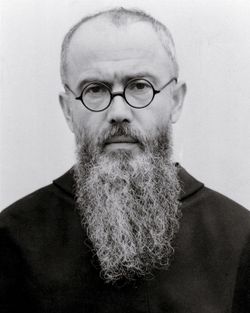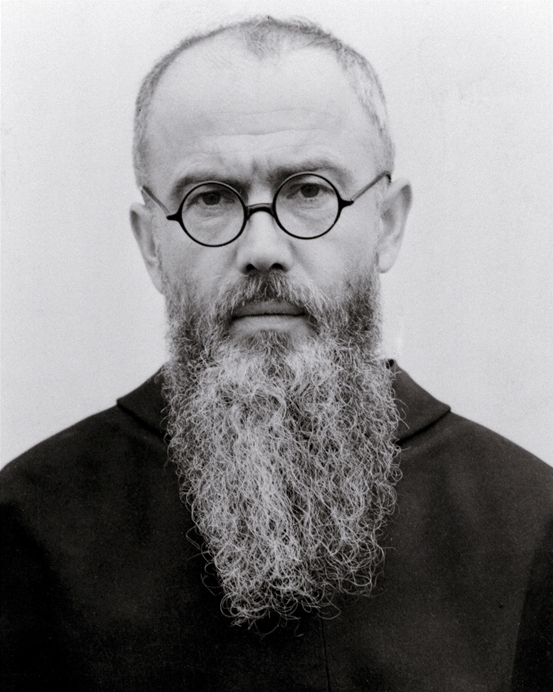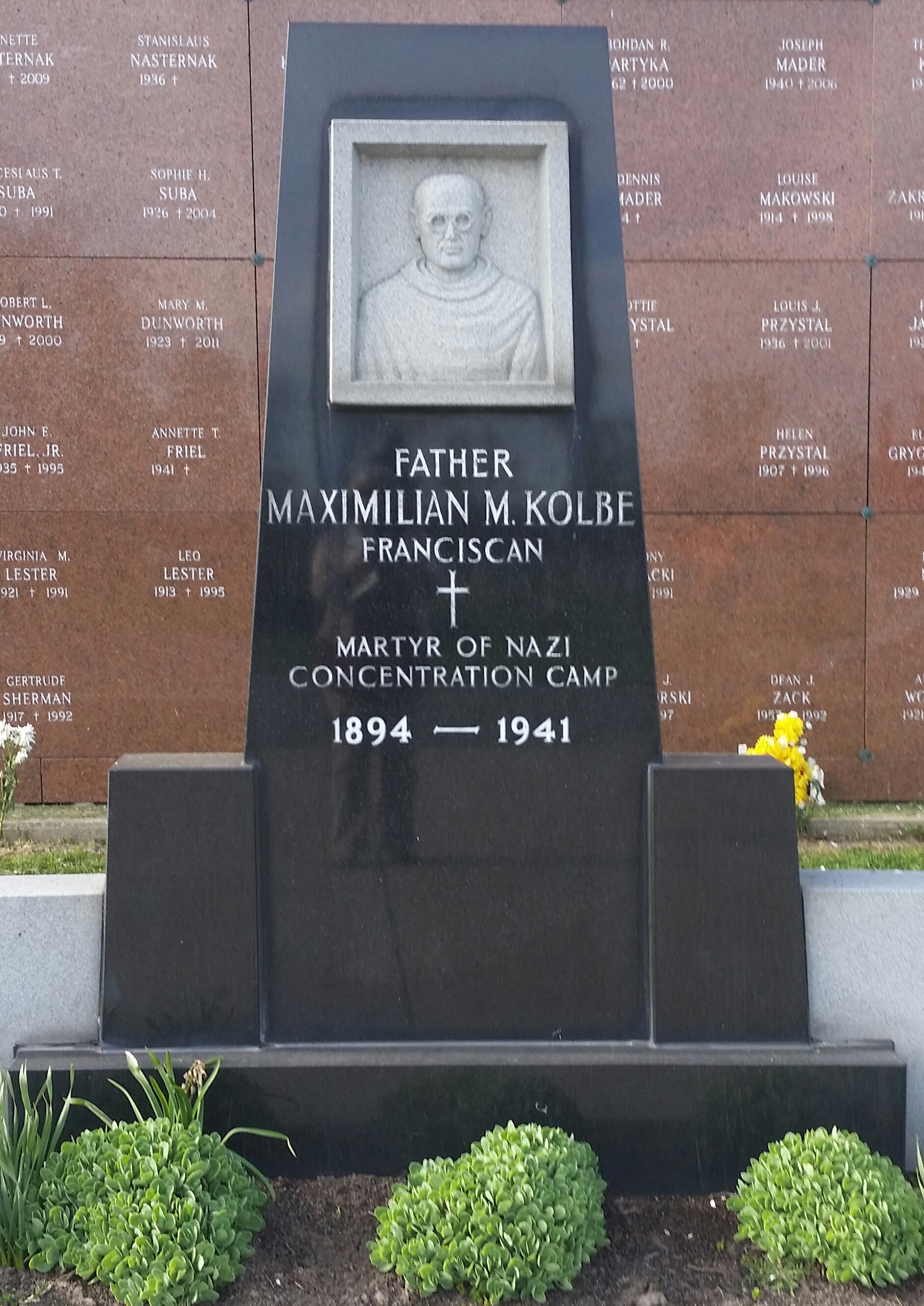Roman Catholic Saint. He received recognition for his heroic deeds during trying times during World War II in a Nazi concentration camp. Born Raymund Kolbe, the second son of a German father and a Polish mother, in what was then the Russian Empire, his life was strongly influenced by the claim at age twelve of a vision of the Virgin Mary. In 1915, he earned a doctorate in philosophy from the Pontifical Gregorian University, became a priest in 1918 in Krakow, and earned a doctorate in theology by the time he was 28. Eventually, along with his elder brother, Francis, he became a Polish Conventual Franciscan friar. In 1927, he founded a huge Polish monastery west of Warsaw dedicated to the Blessed Virgin Mary, called "Niepokalanów" or "The Immaculate One", which eventually had 700 monks. With the monastery becoming a major religious publishing center, he published a periodical, "Knight of the Immaculate," which promoted the veneration of the Immaculate Virgin Mary throughout Poland. He founded monasteries in Japan and India. By 1936, his health was declining, and with the invasion of Poland by Nazi Forces in 1939, he was the only person remaining in the monastery and publishing anti-Nazi literature. After hiding 2,000 Jews from German persecution and refusing to sign a document stating he was a German citizen, he was arrested by Nazi Gestapo on February 17, 1941, and taken to the Pawiak prison, and three months later, he was transferred to Auschwitz Concentration Camp at in Oswiecim, Poland. After two months at Auschwitz, the SS doctors and guards selected a group of men for experiments and execution. When a family man, Franciszek Gajowniczek, asked to live, Father Kolbe stepped forward and took the man's place in the line. For this action, the SS guards removed him to the infamous Block 11. This was where the cruelest of medical experiments were performed by SS physicians using prison inmates for their trials. He remained calm and continued his priestly duties when needed. He was condemned to dehydration and starvation, and after weeks of torture, his Nazi captors murdered him with a lethal injection of carbolic acid on August 14, 1941. His remains were cremated on August 15th, the same day as the Assumption of Mary feast day. His ashes were blended with others that were cremated. On October 10, 1982, Pope John Paul II canonized Kolbe, declaiming him a martyr of charity and making him Saint Maximilian. He is the patron saint of prisoners, the pro-life movement, and people who are afflicted with addiction. Today, his cell at Auschwitz, Cell 18, is a destination for pilgrims as a place to visit and pray. Besides the cenotaph bust of Saint Maximilian Kolbe in St. Stanislaus Cemetery, there are at least six statues erected in honor of him, including ones at the monasteries in Poland and Japan. Above the Great West Door, his 1998 statue is one of the ten on exhibit at the Gallery of 20th Century Martyrs at Westminster Abbey in London. The statue was carved by Andrew Tanser.
Roman Catholic Saint. He received recognition for his heroic deeds during trying times during World War II in a Nazi concentration camp. Born Raymund Kolbe, the second son of a German father and a Polish mother, in what was then the Russian Empire, his life was strongly influenced by the claim at age twelve of a vision of the Virgin Mary. In 1915, he earned a doctorate in philosophy from the Pontifical Gregorian University, became a priest in 1918 in Krakow, and earned a doctorate in theology by the time he was 28. Eventually, along with his elder brother, Francis, he became a Polish Conventual Franciscan friar. In 1927, he founded a huge Polish monastery west of Warsaw dedicated to the Blessed Virgin Mary, called "Niepokalanów" or "The Immaculate One", which eventually had 700 monks. With the monastery becoming a major religious publishing center, he published a periodical, "Knight of the Immaculate," which promoted the veneration of the Immaculate Virgin Mary throughout Poland. He founded monasteries in Japan and India. By 1936, his health was declining, and with the invasion of Poland by Nazi Forces in 1939, he was the only person remaining in the monastery and publishing anti-Nazi literature. After hiding 2,000 Jews from German persecution and refusing to sign a document stating he was a German citizen, he was arrested by Nazi Gestapo on February 17, 1941, and taken to the Pawiak prison, and three months later, he was transferred to Auschwitz Concentration Camp at in Oswiecim, Poland. After two months at Auschwitz, the SS doctors and guards selected a group of men for experiments and execution. When a family man, Franciszek Gajowniczek, asked to live, Father Kolbe stepped forward and took the man's place in the line. For this action, the SS guards removed him to the infamous Block 11. This was where the cruelest of medical experiments were performed by SS physicians using prison inmates for their trials. He remained calm and continued his priestly duties when needed. He was condemned to dehydration and starvation, and after weeks of torture, his Nazi captors murdered him with a lethal injection of carbolic acid on August 14, 1941. His remains were cremated on August 15th, the same day as the Assumption of Mary feast day. His ashes were blended with others that were cremated. On October 10, 1982, Pope John Paul II canonized Kolbe, declaiming him a martyr of charity and making him Saint Maximilian. He is the patron saint of prisoners, the pro-life movement, and people who are afflicted with addiction. Today, his cell at Auschwitz, Cell 18, is a destination for pilgrims as a place to visit and pray. Besides the cenotaph bust of Saint Maximilian Kolbe in St. Stanislaus Cemetery, there are at least six statues erected in honor of him, including ones at the monasteries in Poland and Japan. Above the Great West Door, his 1998 statue is one of the ten on exhibit at the Gallery of 20th Century Martyrs at Westminster Abbey in London. The statue was carved by Andrew Tanser.
Bio by: Linda Davis
Family Members
Advertisement
See more Kolbe memorials in:
Explore more
Sponsored by Ancestry
Advertisement







